Cloud gaming will save you money but won't save the planet
It's certainly easier on the wallet, but all those datacenters don't run on rainbows and clean flowing water, you know.

I’ve never thought about my energy costs as a PC gamer. Sure, if I sit and think about it, running my own gaming PC uses more power than a console like the PS5, Switch or Xbox Series X, but so what? We're talking pennies, right? But things have changed. We've seen huge hikes in the price of electricity in Europe, but also some chunky rises in the US too with more to come.
It's time for a rethink.
I've dabbled with cloud gaming via GeForce Now, and you can spec up a great virtual PC using Shadow (from $30 a month and limited states), but I decided to find out how much money and power I could be saving by comparing my desktop gaming PC to Google Stadia. I chose Stadia as it's the lowest-powered, and lowest cost, option. It doesn’t even require a basic laptop, just any dumb screen with an HDMI port and a Chromecast that runs at just 2 watts peak. GeForce Now with the Nvidia Shield TV came a close second, but that draws more power and costs a whole lot more to get started with.
So a Stadia, my rig and a few measuring tools are all I need to find out how much you could be saving by "offshoring" the heavy lifting. Of course, I also wanted to find out if the experience of gaming on Stadia can compete with my home rig too.
Cloud gaming can save you more than you think
First, I need to make a big distinction. Electricity is a lot more expensive in the UK than it is in the US—for the most part. The average price for a kWh in the UK is £0.28, which works out to $0.36 while the average in the US is $0.14 per kWh. But in the UK the regions are pretty similar in cost, while in the US they vary a lot.
You might well go meh at electricity savings when the cost is just in $0.10 kWh Nebraska. If you live in $0.38 kWh Hawaii, though, there are a lot of savings to be had.
GPU: Nvidia GTX 1070 Ti
CPU: AMD Ryzen 7 5800X
RAM: 32GB DDR4
Storage: SSD
Monitor: Dell 2515H (1440p)
To gather energy data I used a power meter plug that I tested using low wattage lights and a space heater. The power used matched the manufacturer's wattage specifications so I was happy the plug was accurate to within 5%, at least.
The biggest gaming news, reviews and hardware deals
Keep up to date with the most important stories and the best deals, as picked by the PC Gamer team.
I then chose to use the same game across both Stadia and PC. I wanted a game with high CPU and GPU requirements and one I could play on both platforms. Control, the award-winning 2019 third-person shooter, fit the bill.
I played the first hour of the game on each platform, using the same monitor and headset. The only difference was that I was playing via the cloud in one instance and on my local PC in the other.
The results were stark. Playing on my PC used 12 times more power than on Stadia—10 pence versus 0.8p for me, or 4.9c versus 0.4c for the US average.
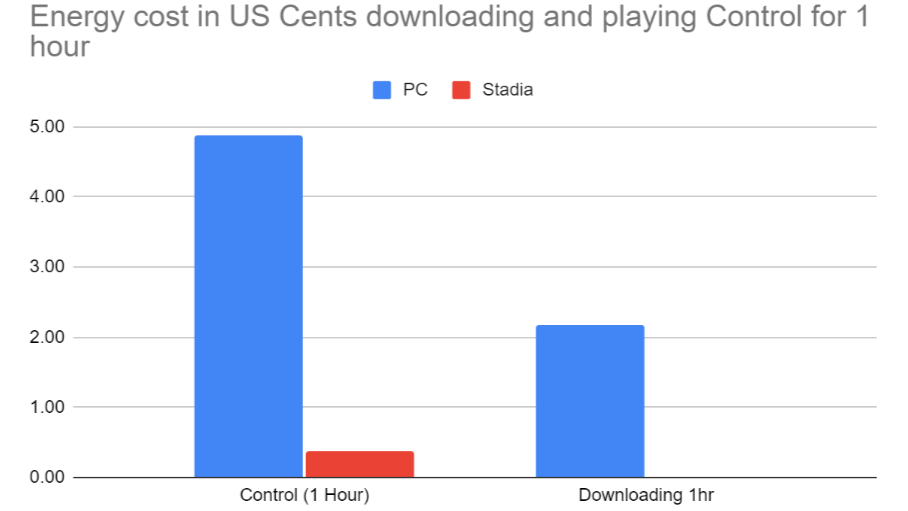
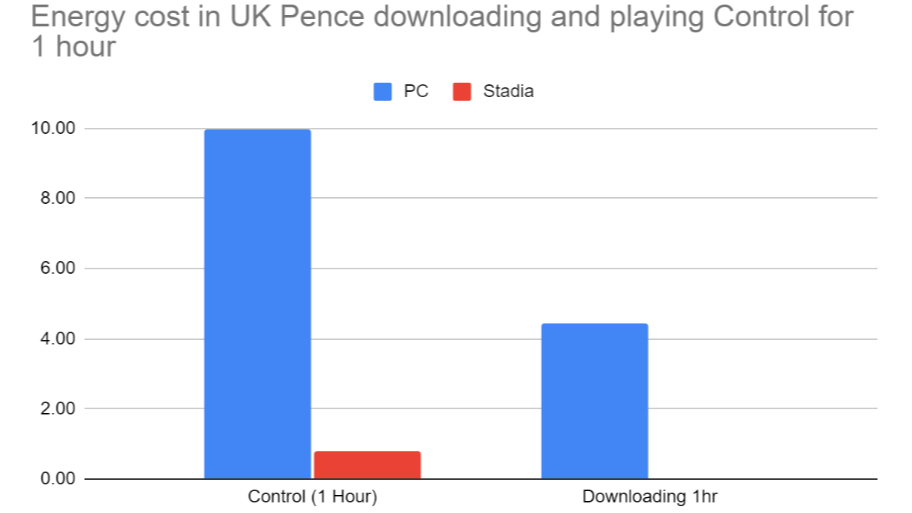
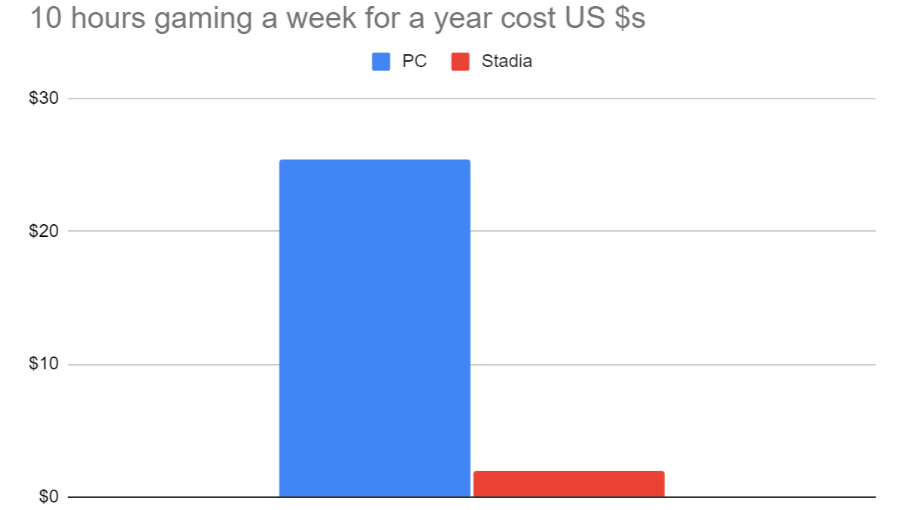
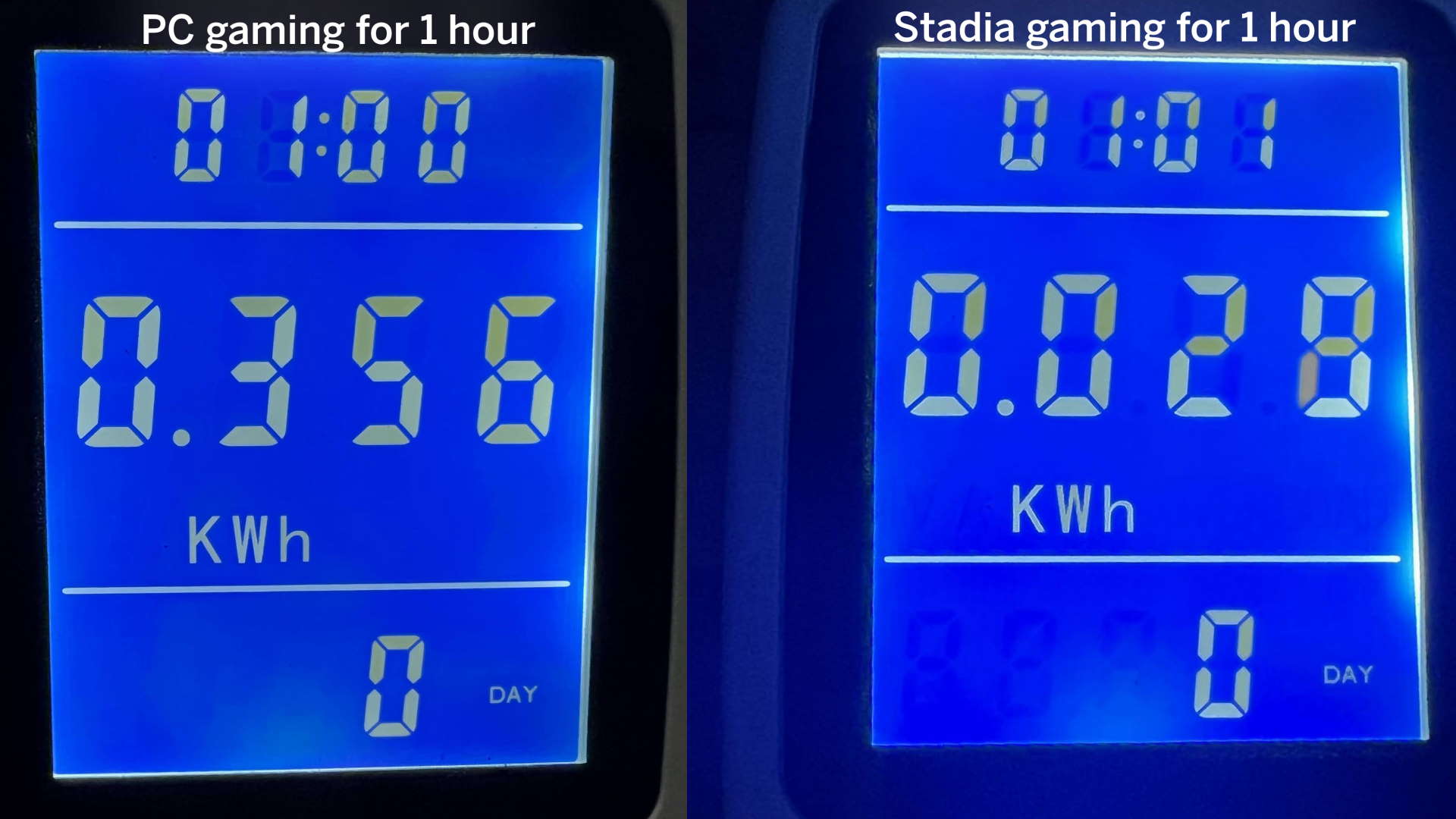

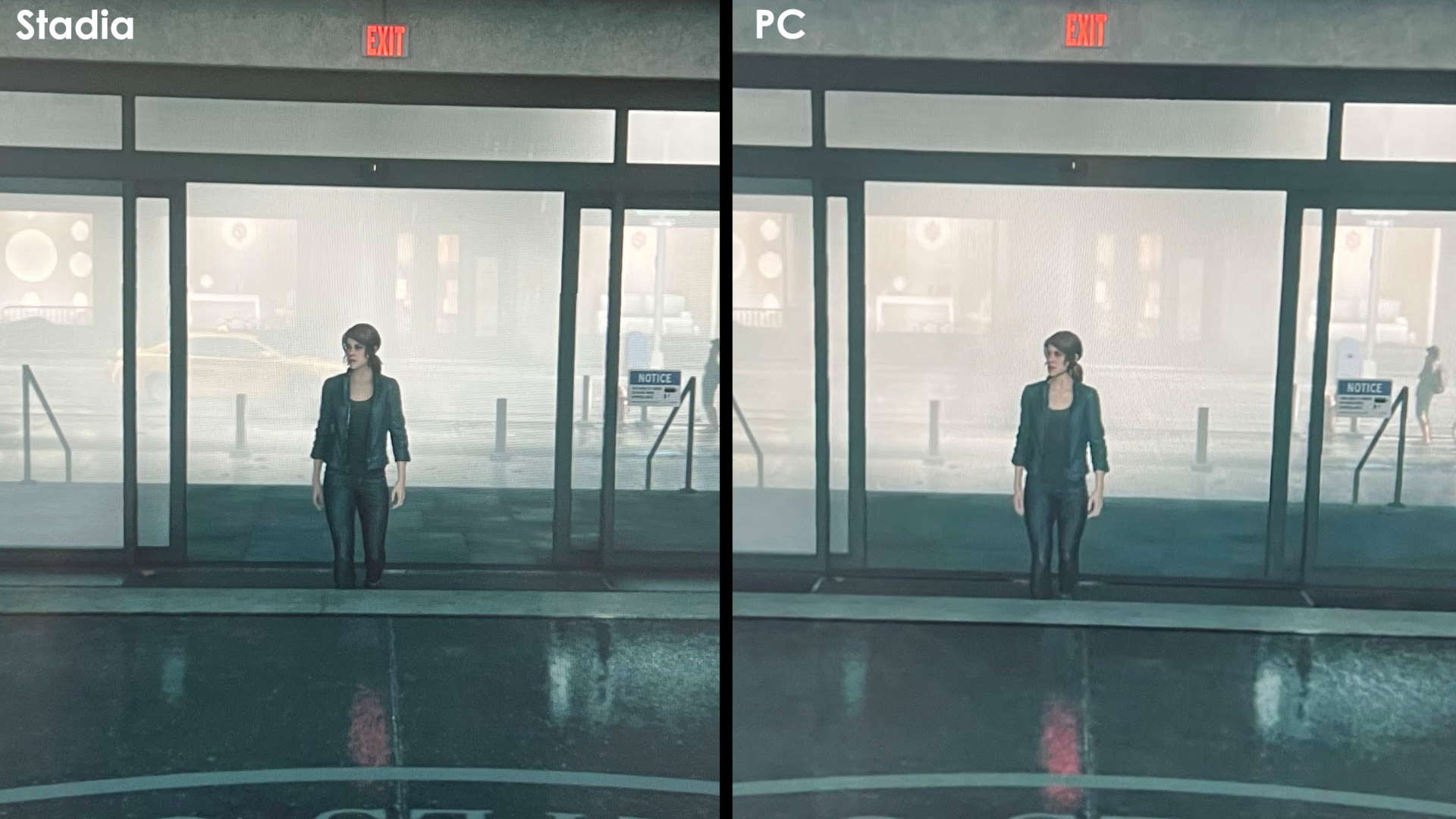
Playing on my PC used 12 times more power than on Stadia
Doesn’t sound like much does it? But let me add some context. I recently completed Cyberpunk 2077 on Stadia, clocking 88 hours of game time. That saved me £8 (or $10) on my electricity bill. The more you play the bigger the savings, and that’s before you factor in the cost of buying a gaming PC.
There are more savings when you consider you don’t need to download or install games either. There are no long waits or chunky updates.
Downloading and installing a game on my PC uses a lot less power as the GPU doesn’t get taxed. Downloading Control for an hour used 160 watts, a little less than half what playing the game for an hour used. Depending on your internet connection, downloading the 60GB Cyberpunk 2077 install can take quite a few hours and add more to your bills.
There's a reason I've been a PC gamer for more than 30 years, however, albeit one with an ageing GPU. I like tinkering and I like modding and I like setting things up juuuust right. But the older I get, the less time I have and the more I just want to get to the gaming bit without any of the hassles. And while there's no modding or much tinkering to be had with Stadia, there is also very little to complain about either.
That said if you have a huge Steam or Epic Games libraries like I do then Stadia might not hack it. If that's the case then Nvidia's GeForce Now is a solid option that can still provide significant electricity savings if you're using a Shield TV or a low-powered laptop.
| Header Cell - Column 0 | Monthly fee | Session limit | 1080p | 60fps | 4K | 60fps | 4K | 120fps |
|---|---|---|---|---|---|
| Google Stadia | Free | None | Yes | No | No |
| Google Stadia Pro | $9.99 | None | Yes | Yes | No |
| GeForce Now | Free | 1 hour | Yes | No | No |
| GeForce Now Priority | $9.99 | 6 hour | Yes | No | No |
| GeForce Now RTX 3080 | $19.99 | 8 hour | Yes | Yes | Yes |
| PlayStation Now | $9.99 | None | Yes | No | No |
| Shadow | $29.99 | None | Yes | Yes | No |
| Xbox Cloud with Game Pass | $14.99 | None | Yes | No | No |
The Stadia experience is smooth
The only reason I preordered a Founder's Edition Stadia is that I'm a tech journalist. I've never been particularly excited by cloud gaming, but I did want to see how Google managed after experiencing a few false dawns. Ouya anyone?
I was quite impressed playing Destiny 2. Very little lag, smooth frame rate, sharp graphics—well done Google.
I then got bored.
There weren't many players playing it and there weren’t many titles to choose from. When there was a game I wanted to play, like AC Valhalla, I ended up getting in on the PC. The deals were better, why pay £50 on Stadia when I could get it for £35 elsewhere?
That changed when I bought Cyberpunk 2077 on Stadia. I was going away for Christmas and realized Stadia makes a lot of sense when you’re traveling somewhere and want to game when you get there. The tiny Chromecast, the well-balanced controller, and a decent Wi-Fi connection are all you need to play a AAA game. That and pretty much any screen like a TV, smartphone, tablet, or monitor.
Or so I thought. Unfortunately, Stadia is not available in all regions, so I could not play Cyberpunk at first. Annoying, sure, but I got around it using a VPN and had a blast.
I loved the game and the Stadia experience barring another annoying issue. Often, after an hour or so of playing, the game would crap out. Frame rates would drop to unplayable levels and I’d have to exit and wait a bit to log back into another server.
Other than that Stadia works great. The controller is comfortable and solid, and the overall experience is not far off current-gen console gaming. Add to those benefits that it's easy to drop in a bag and you've got a portable gaming powerhouse.
If you’re a bleeding-edge 4K+ PC gamer, or a mouse and keyboard warrior, then Stadia may not hack it for you. But if, like me, you're toting some older hardware it's a very close run thing indeed. In fact, with Stadia Pro (£8.99 UK, $9.99 US, €9.99 EU per month) and a 4K TV or monitor, Stadia can stream 4K HDR at 60 fps. Otherwise, you can just buy the game and play at 1080p/60 without the monthly outlay.
If you can buy the Stadia setup for £20 a pop with three months' worth of Stadia Pro as I did, then I say get it right away. I bought four and gave them away as Christmas presents and they went down a treat. Even if you don't want to wait you can find plenty of brand new Stadia kits on eBay for £30 in the UK or $40 in the US. Compare that to the cost of a PC or console and the electricity savings become the icing on the cake.
There are a few more things to consider before you ditch the gaming PC though...
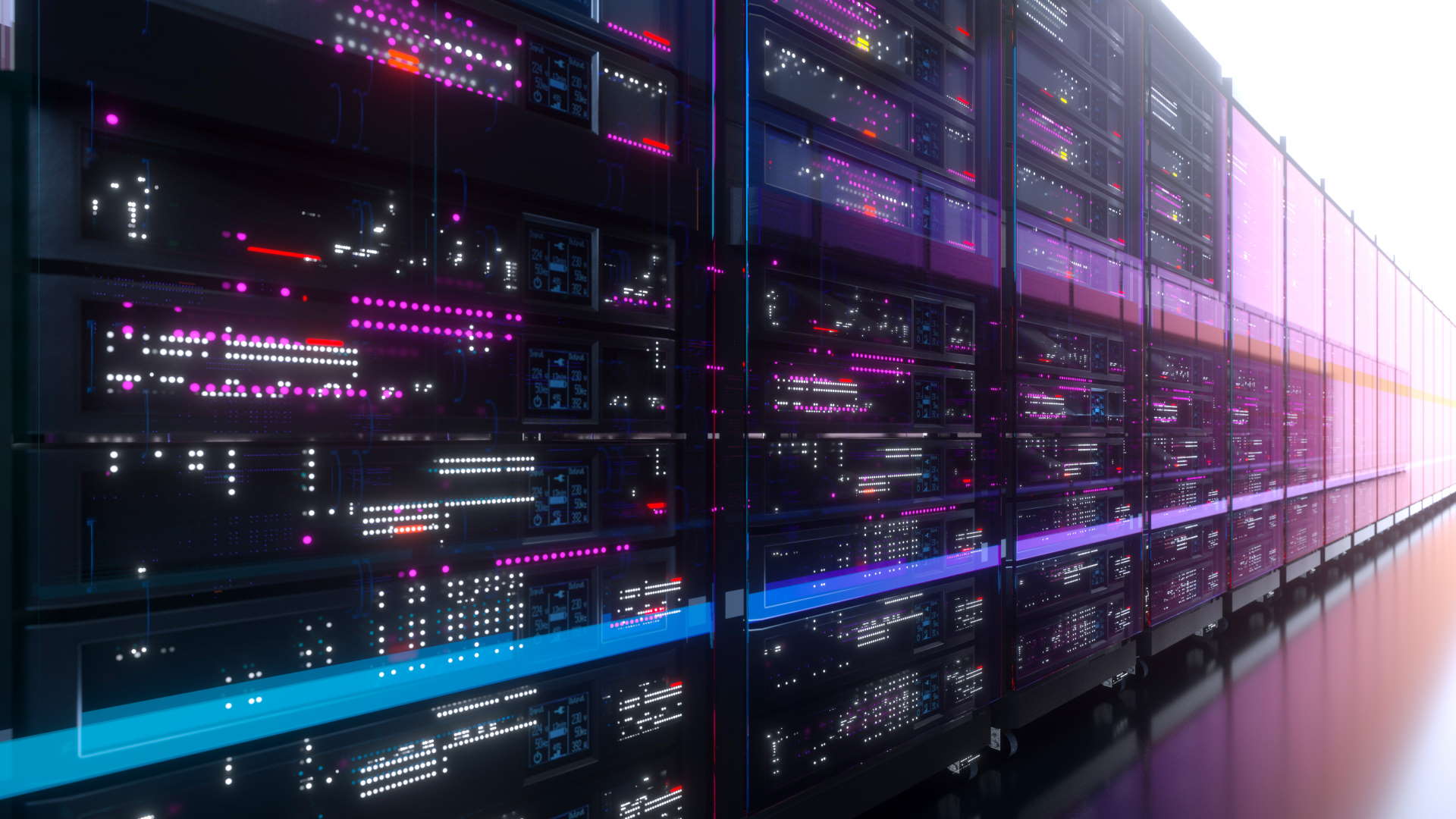
The cloud gaming paradox
Stadia uses around 2W plugged into the back of a TV, but an extra 520W across both the network and data center
While cloud gaming can be good for your pocket it is not good for the planet.
It's not clear exactly how much electricity cloud gaming uses; cloud gaming services like Stadia or Nvidia Now might not use a lot of electricity in your home, but they do use a lot of data center and network capacity. The game has to run on servers using up electricity, then the whole thing also needs to stream to you. That means it uses a whole lot more electricity than, say, Netflix which uses a lot of network energy but very little data center energy.
Studies have been conducted that show how much more thirsty cloud gaming is.
Stadia uses around 2W (1W idle) plugged into the back of a TV, but can use an extra 520W across both the network and data center, making it far more energy-intensive than playing locally. In fact, one of the studies found that using a console for cloud gaming used 156% more energy than local gaming. That’s a major bummer if you care about the environment and climate change.
There are counterarguments, of course. Google claims its data centers are twice as efficient as other data centers, halving Stadia's emissions, if accurate. It also says that its data centers are carbon neutral. I won’t go into the ins and outs of carbon neutrality here, but let’s say carbon-neutral does not mean a company suddenly farts out bees and black rhinos instead of CO2. It just means it can "offset" carbon use by investing in green projects.
Another upside to the planet is the lack of physical media, huge downloads, and all the PC and console landfill waste. All this helps somewhat balance out what can make cloud gaming look like an environmental disaster by comparison.
Cloud gaming is the money-savvy gamer’s best friend
Whether you like it or not, cloud gaming is what gamers feeling the pinch of rising energy prices should be doing. It offers a solid experience on any screen and if you game a lot the savings will be real.
That’s before we even go into the price-gouging cost of GPUs right now.
My experience playing Cyberpunk has seriously made me rethink whether the next game I want to play I’ll buy for my PC or on a cloud gaming platform. Despite slow takeup, Stadia and other PC streaming platforms like GeForce Now will continue to grow, as will new players like Amazon’s Luna, Blacknut and Boosteroid.
In the meantime, with prices on everything rising you can use Stadia or GeForce Now to your advantage and save some precious pennies.
Evan has been a tech-head since he was handed a ZX Spectrum at the age of 6 and has always been the one analyzing and recommending products to his friends and family or explaining how things work and how to fix them when they don't. He has been working on magazines and websites since 2000 and was Editor-in-Chief of Trusted Reviews covering topics such as mobile, tablets, audio, computing and smart home for 7 years as well as supporting the tech and buying advice sections of Time.com, Space.com, LiveScience.com and NME.com. In his 20+ year career, he has reviewed and covered everything from laptops to coffee machines and smartphones to smart thermostats and has been quoted on the BBC, among others. He won IPC Media's Editor of the Year in 2013 and has been shortlisted for multiple AOP Digital Publishing and PPA Digital Publishing awards.


